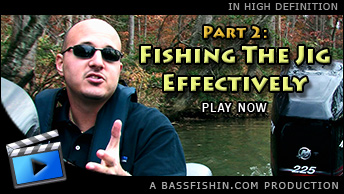
Fishing The Jig Effectively
The second video of a two-part series covering jig fishing. Kevin details the many strategies and techniques that will help anglers fish the jig more effectively on the water. He covers common scenarios and how to attack them, the different theories on how to approach cover, bite detection and power fishing. And if you haven't checked out the first video of this 2-part jig fishing series, you may want to watch that one first.

Partial Transcript: If you missed our jig fishing video that is all about how to choose the proper jig, modify it to make it better, equipment strategies, and so forth, you may want to go check out that video right now, or later, because that video is a continuation of this one. We're now ready to start fishing, but the one thing we haven't discussed thus far is what size jig to fish. The most common jig sizes are 1/4 oz., 3/8 oz., and 1/2 oz. So lets first approach some common jig fishing scenarios, and I'll give you my take as to what jig you should be fishing.
Here is your classic jig fishing scenario. You have a laydown in 0-5 ft of water and it's mid-spring. You're going to want to fish a 3/8oz. jig in this case. A 1/4oz. jig is too small and has too slow of fall. A 1/2oz. jig isn't too big, but it's fast fall may take the lure out of the strike zone too quickly.
Is there any reason to ever fish a 1/2 oz. here? The answer is yes. In the summer when the water temps are warm, and sometimes in the fall when fish are at their most active, a 1/2 oz. will trigger more reaction strikes. So if it's summer and the water is warm, kick it up to 1/2 oz. to get that reaction bite. Conversely, the 1/4 oz. is your best choice here when water temps are cold, like in winter. The few fish that stay shallow during the colder months will need coaxing with a slower, 1/4 oz. fall.

- Review: Minn Kota vs. MotorGuide
- The Blog: Vintage Fishing Tackle Videos
- The Blog: Join Me In Standing Up Against...
- Review: Biography of Clay Dyer - Amazing!
- Review: Lazer Trokar Hooks: My Impressions
- Review: Suffer Eye Irritation From Boating?
- Video: SpaceNavigator For Geospatial Apps
- Video: The "Wiffle Spool" Trick
- Video: Setting Brake On Baitcasters
- Video: Preventing Twists On Spinning Reels
- The Blog: The Fishing Line Guide
- Video: The Geospatial Advantage
- Video: Baitcaster Backlash 'Thumb Trick'
- Store: Big Bass Zone
- Special: The BassFishin.Com Newsletter
- Video: How To Texas Rig A Bait




